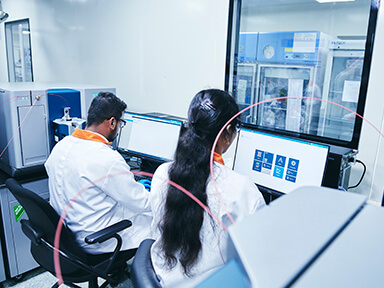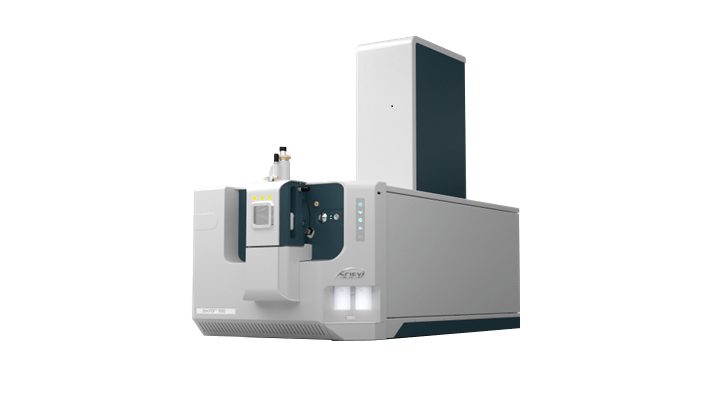Overview
Open up biomarker discovery with a new depth of proteomics knowledge and help make disease characterization possible at earlier stages. Discover biomarkers that can guide early treatment of diseases with next-generation and targeted proteomics knowledge, and gain confidence in your results from drug discovery through translational research and beyond.
Workflow
Biomarker discovery
Discover, quantify and translate previously unknown biomarkers by uncovering unique fragmentation patterns and low-abundance species. Work with SCIEX experts to develop integrated analytical systems and novel methods for biomarker discovery that make new treatments for diseases possible at earlier stages.
-
Discover novel biomarker candidates that facilitate drug discovery and development
-
Perform large-scale experiments with powerful, high-throughput workflows and solutions
-
Uncover candidate biomarker signatures with high sensitivity, robustness and reproducibility
Biomarker discovery
Solution
- Qualitative flexibility combined with quantitative power
- Precise perspectives on the proteome
Featured resources
Learn how plasma protein quantitation could potentially enable better disease management and prognosis for patients with COVID-19 infections.
Find out how data-independent acquisition (DIA) using the ZenoTOF 7600 system enables fast quantitative proteomics.
The unique electron activated dissociation (EAD) cell enables fast and reproducible fragmentation, even for peptides with large post-translational modifications (PTMs). Tuneability within the EAD cell further ensures that critical MS/MS information is retained for PTM characterization with high confidence.
Workflow
Biomarker validation
Leverage state-of-the-art, high-throughput solutions to facilitate large scale validation of candidate biomarkers whether batch-to-batch or sample-to-sample. With reliable and robust performance, and expert-level support services for faster analyses and nanoscale-level sensitivity, SCIEX enables accurate identification and quantitation.
-
Identify and quantify biomarkers accurately and consistently
-
Confidently validate candidate biomarkers with large-scale comparisons
-
Establish fast, highly sensitive, robust and reproducible biomarker validation workflows
Biomarker validation
Solution
- Qualitative flexibility combined with quantitative power
- Precise perspectives on the proteome
Featured resources
Learn how high-sensitivity LC-MS/MS enables quantitation of the structurally isomeric biomarkers glucosylsphingosine (GlcSph) and galactosylsphingosine (GalSph) in cerebral spinal fluid, even at very low levels.
Workflow
Translational medicine
Discover the next biomarkers that will drive improvements in human health using state-of-the-art technologies that provide nanoscale-level sensitivity for fast and accurate identification and quantitation. Rely on solutions that couple innovative hardware with versatility in data processing so you can quickly find the right compound to move forward with in vivo testing and validation in the clinical environment.
-
Perform large-scale comparisons to identify the most promising compounds for drug development
-
Enable fast, accurate identification and quantification using sensitive, robust and reproducible technologies
Translational medicine
Solution
- Qualitative flexibility combined with quantitative power
- Precise perspectives on the proteome
Translational medicine
Solution
Featured resources
Small-molecule drug discovery in academia is all about teamwork. Learn from Florence Raynaud of the Institute for Cancer Research how LC-MS helps her team find suitable small-molecule candidates for in vivo testing.
Learn why the Citrine system is a go-to solution at Wake Forest School of Medicine for creating new rapid, accurate and reliable analytical methods for clinical applications.
All resources
Learn how plasma protein quantitation could potentially enable better disease management and prognosis for patients with COVID-19 infections.
Find out how data-independent acquisition (DIA) using the ZenoTOF 7600 system enables fast quantitative proteomics.
Discover how quickly electron activated dissociation (EAD) can reproducibly fragment peptides with post-translational modifications (PTMs) while retaining critical MS/MS information for PTM identification.
Learn how high-sensitivity LC-MS/MS enables quantitation of the structurally isomeric biomarkers glucosylsphingosine (GlcSph) and galactosylsphingosine (GalSph) in cerebral spinal fluid, even at very low levels.
See how multiple reaction monitoring (MRM) provides accurate measurements of small and large biological changes across large and varying sample cohorts to support faster microflow chromatography runs.
Small-molecule drug discovery in academia is all about teamwork. Learn from Florence Raynaud of the Institute for Cancer Research how LC-MS helps her team find suitable small-molecule candidates for in vivo testing.
Learn why the Citrine system is a go-to solution at Wake Forest School of Medicine for creating new rapid, accurate and reliable analytical methods for clinical applications.
Associated applications

Biomarker quantitation
Explore the potential of trusted LC-MS/MS solutions designed to simplify and accelerate biomarker quantitation. Bring drug candidates through the development pipeline more efficiently and confidently with accurate results obtained using innovative hardware and software, lab-tested methods and expert support.
